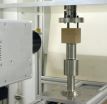(Press-News.org) Johns Hopkins Kimmel Cancer Center scientists have completed a comprehensive map of genetic mutations occurring in the second-most common form of brain cancer, oligodendroglioma. The findings, reported in the Aug. 4 issue of Science, also appear to reveal the biological cause of the tumors, they say.
To create the map, the scientists sequenced protein-coding genes in seven oligodendroglioma tissue samples, and focused attention on recurring mutations in two genes not previously associated with these tumors – CIC and FUBP1. The investigators say that CIC and FUBP1 are known to regulate cell-signaling processes, and CIC mutations have been rarely linked to sarcoma, breast and prostate cancers.
More mutations in the two genes were found in an additional 27 oligodendroglioma samples. In all, two-thirds of the samples studied had CIC and FUBP1 mutations.
"Whenever we find genes mutated in a majority of tumors, it is likely that the pathway regulated by that gene is critical for the development and biology of the tumor," says Nickolas Papadopoulos, Ph.D., associate professor of oncology at the Johns Hopkins Kimmel Cancer Center.
In brain cancer, the Hopkins investigators say CIC and FUBP1 mutations may be the "missing link" in what scientists describe as a "two-hit" theory of cancer development. The theory is based on the fact that each cell in the human body has two copies of 23 chromosomes containing thousands of protein-producing genes. If a gene on one chromosome is damaged or deleted, the other copy makes up for the loss of protein. But if the second copy fails as well, the cell cannot make the proper protein and may become cancerous.
In oligodendrogliomas, the "first hit" has long been known to occur in regions of chromosome 1 and 19, which fuse together resulting in a loss of many genes on both chromosomes. Up to 70 percent of oligodendroglioma patients have these DNA fusions, and most of them respond better to chemotherapy and radiation than those who lack the deletions in the chromosomes. For more than a decade, researchers have been looking for evidence of a "second hit" in specific mutated genes that allow oligodendrogliomas to develop.
In the current study, the Johns Hopkins investigators found mutations in the remaining copies of the CIC and FUBP1 genes on chromosomes 1 and 19, suggesting that these mutations represent the second hit needed to create cancer.
"Thanks to the Human Genome Project and advances in cancer genome sequencing, a single study can now resolve decade-old questions and reveal the genetics of this brain cancer," says Kenneth Kinzler, Ph.D., professor and co-director of the Ludwig Center at Johns Hopkins. "Knowing the genetic roadmap of a cancer is the key to attacking it."
Oligodendrogliomas account for up to 20 percent of brain cancers and more commonly occur in younger people aged 30 to 45. The cancer forms most often in the frontal lobe of the brain in cells that coat neurons. Median survival of 10 years is considered far better than other brain cancers. Oligodendrogliomas are treated initially with surgery, followed by chemotherapy and radiation.
The research team says its next step will be to test whether patients with CIC and FUBP1 mutations have the same favorable prognosis as those who have the chromosome 1 and 19 fusion, says Chetan Bettegowda, M.D., Ph.D., chief resident in the Department of Neurosurgery at Johns Hopkins.
"We can focus now on when these mutations develop during tumor formation, whether they can guide prognosis, and how they might form targets for therapy," says Bettegowda.
Bettegowda says the gene map uncovered mutations in other genes, such as PIK3CA, which have been well-studied in cancer. It is possible, he says, that oligodendroglioma patients with mutations in PIK3CA or other genes could be enrolled in current clinical trials using experimental therapies that target these mutations.
INFORMATION:
Funding for the research was provided by the Virginia and D.K. Ludwig Fund for Cancer Research, the Pediatric Brain Tumor Foundation, the Duke Comprehensive Cancer Center Core, the Burroughs Wellcome Fund, the James S. McDonnell Foundation, state funding from Sao Paulo (FAPESP), the National Cancer Institute and National Institutes of Health.
Contributors to the research include Nishant Agrawal, Yuchen Jiao, Mark Sausen, Laura D. Wood, Ralph H. Hruban, Fausto J. Rodriguez, Daniel P. Cahill, Gregory Riggins, Victor Velculescu and Bert Vogelstein of Johns Hopkins; Roger McLendon, Darell Bigner and Hai Yan of Duke University; and Sueli Mieko Oba-Shinjo and Suely Kazue Nagahashi Marie of the University of Sao Paulo, Brazil.
Under agreements between the Johns Hopkins University, Genzyme, Exact Sciences, Inostics, Qiagen, Invitrogen and Personal Genome Diagnostics, Papadopoulos, Vogelstein, Kinzler and Velculescu are entitled to a share of the royalties received by the University on sales of products related to genes and technologies described in this manuscript. Papadopoulos, Vogelstein, Kinzler, and Velculescu are co-founders of Inostics and Personal Genome Diagnostics stock, which is subject to certain restrictions under Johns Hopkins University policy.
www.hopkinskimmelcancercenter.org
www.sciencemag.org
END
(NEW YORK, NY, (August 4, 2011) – Columbia University Medical Center researchers have for the first time directly converted human skin cells into functional forebrain neurons, without the need for stem cells of any kind. The findings offer a new and potentially more direct way to produce replacement cell therapies for Alzheimer's and other neurodegenerative diseases. Such cells may prove especially useful for testing new therapeutic leads. The study was published in the August 4 online issue of the journal Cell.
In another first, the researchers used this method — called ...
PASADENA, Calif.—Stretching for thousands of miles beneath oceans, optical fibers now connect every continent except for Antarctica. With less data loss and higher bandwidth, optical-fiber technology allows information to zip around the world, bringing pictures, video, and other data from every corner of the globe to your computer in a split second. But although optical fibers are increasingly replacing copper wires, carrying information via photons instead of electrons, today's computer technology still relies on electronic chips.
Now, researchers led by engineers at ...
Bond Ladders, a powerful tool for retirement. A bond ladder works by spreading investment dollars among bonds that will mature at various times between one and fifteen years from now. In a normal interest rate environment, shorter maturities will yield less than longer maturities. Think of the individual bonds as rungs on your ladder. As each individual bond matures, your principal is made available for reinvestment at current interest rates.
The value of a ladder is the ability to reinvest the principal from the maturing bond into a new bond with a higher yield. The ...
This press release is available in French.
By working with individuals suffering from a severe disorder that causes sensory neurons to degenerate, researchers at the University of Montreal Hospital and CHU Sainte-Justine Hospital have discovered how a specific genetic mutation causes their patients' condition, which in turn has revealed more information about the mechanisms in our bodies which enable us to sense pain. Genetic mutations are mistakes in our genetic code that can either be passed from parents to their children or created when DNA is replicated. Lead author ...
Honeywell Safety Products announces the new Miller ShockFusion Permanent Horizontal Lifeline (HLL) Roof System - a versatile surface-mounted lifeline system that accommodates most industrial and commercial roof designs including standing seam, membrane, built-up, metal sheathing, concrete and wood.
- Attaches to the surface of existing roof structures - Quick, easy installation reduces costs by requiring minimal labor and eliminating the need for structural roof penetration and repair.
- Significantly reduces system forces on the roof - In the event of a fall, the ...
New Haven, Conn.—Over one-third of the world's population already lives in areas struggling to keep up with the demand for fresh water. By 2025, that number will nearly double. Some countries have met the challenge by tapping into natural sources of fresh water, but as many examples – such as the much-depleted Jordan River – have demonstrated, many of these practices are far from sustainable.
A new Yale University study argues that seawater desalination should play an important role in helping combat worldwide fresh water shortages – once conservation, reuse and other ...
DALLAS – Aug. 4, 2011 – Findings by UT Southwestern Medical Center researchers may suggest new strategies for successful donor adult stem cell transplants in patients with blood cancers such as leukemia, lymphoma and myeloma.
The study, published Aug. 5 in Cell Stem Cell, showed for the first time that adult blood stem cells can be regulated to overcome an immune response that leads to transplant rejection. It also opens up further studies in stem cell immunology, said Dr. Chengcheng "Alec" Zhang, assistant professor of physiology and developmental biology at UT Southwestern ...
Drinking just one 4cl measure of spirits can increase the risk of an acute attack of pancreatitis, but wine or beer does not appear to have the same effect, according to a study published online by BJS, the British Journal of Surgery.
Researchers from the Karolinska Institutet in Sweden followed 84,601 people from 46 to 84 years of age from the general population in Vastmanland and Uppsala for a median of ten years. During that time 513 developed acute pancreatitis.
"Our study revealed a steady increase between each measure of spirits a person drank on one occasion ...
For male houbara bustards sexual extravagance is the key to attracting mates in some of the world's harshest desert environments. However, new research in Ecology Letters reveals that males who perform the most extravagant sexual displays will suffer from premature biological aging and will pass their reproductive prime years earlier than their less ostentatious rivals.
Houbara bustards, Chlamydotis undulata, are found across the deserts of the Southern Hemisphere, from the Persian Gulf to the Gobi Desert, and for six months of the year the males spend their days in elaborate ...
This release is available in German.
People who buy an expensive solid wooden table or wardrobe want to be certain that their new piece of furniture is absolutely faultless. Pianos – whether upright or grand – can only produce an opulent tone if their soundboard, bridge and keyboard are made of high-quality materials. And wood that is free of imperfections is also essential in house building and window construction: load-bearing wooden beams need to be of the highest quality, as even the smallest crack can cause them to fail.
Research scientists from the Fraunhofer ...



